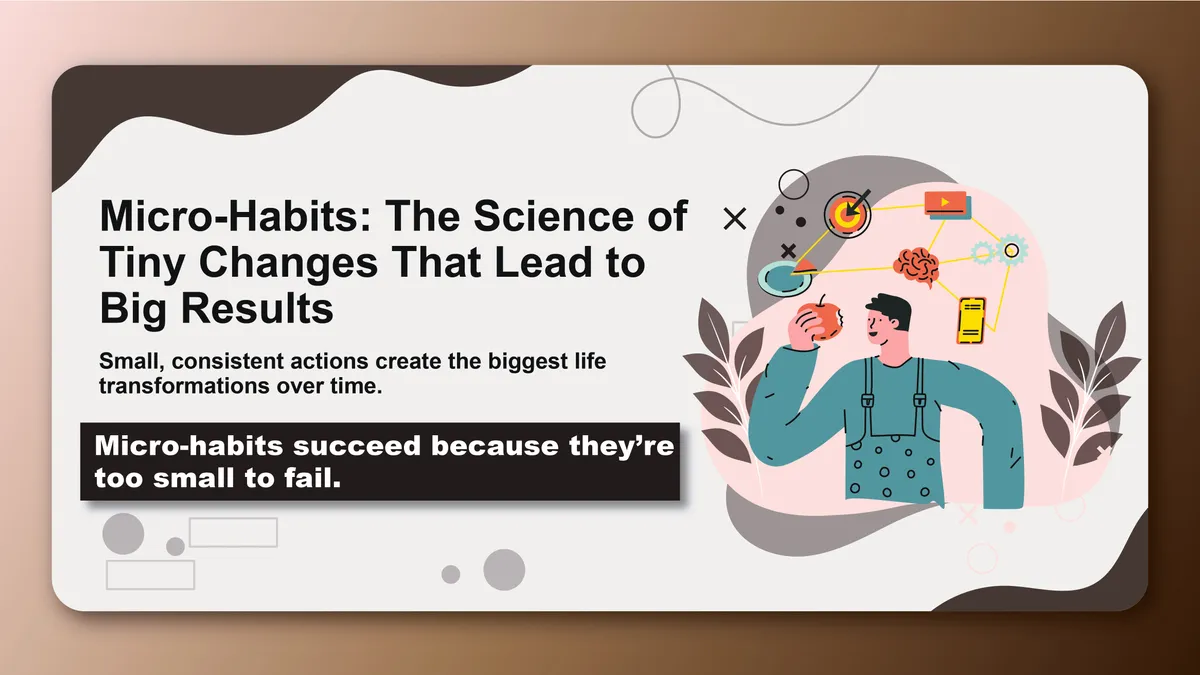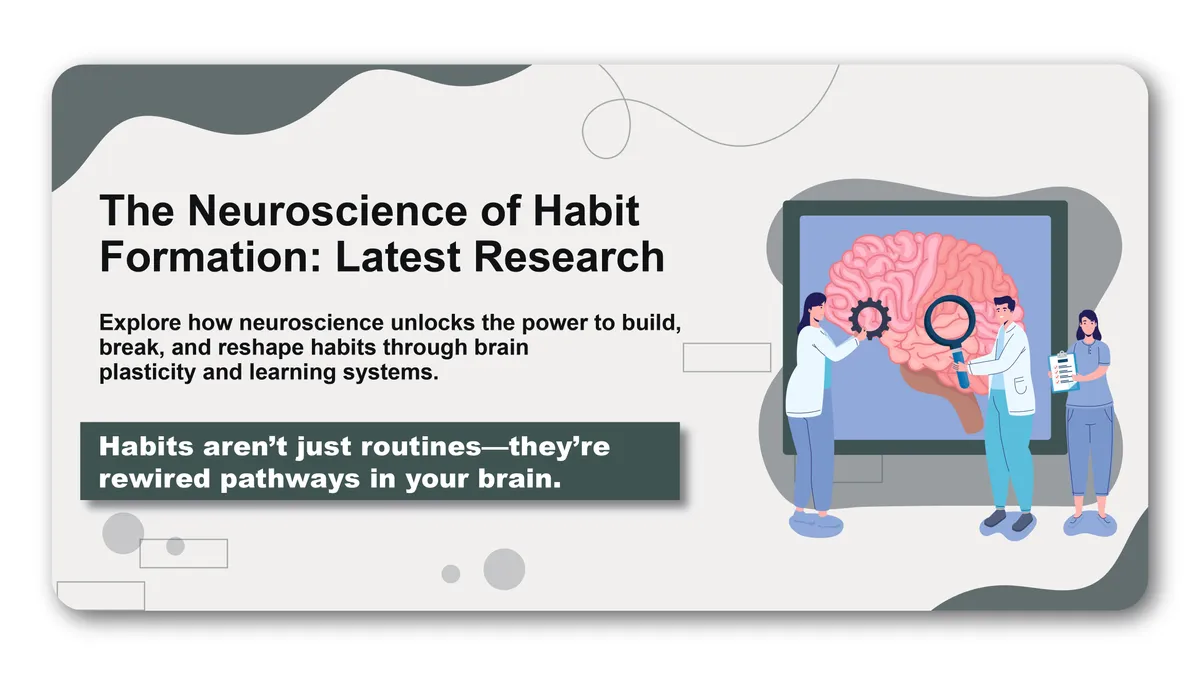What's the smallest amount of effort that can still create a meaningful habit? This question reveals one of the most powerful concepts in behavior change: the Minimum Effective Dose (MED). Originally from medicine and fitness, this principle can revolutionize how you build lasting habits.
The MED is the smallest dose that produces the desired outcome. Any less and you won't see results. Any more and you're wasting energy or potentially causing harm. Applied to habits, this means finding the smallest consistent action that creates real change.
Understanding the Minimum Effective Dose
Medical Origins
The MED concept comes from pharmacology, where it represents the lowest dose of a medication that produces a therapeutic effect. Below this threshold, the medicine doesn't work. Above it, you may get diminishing returns or side effects.
Key Principles:
- Threshold Effect: There's a minimum level required for results
- Efficiency: More isn't always better
- Sustainability: Smaller doses are easier to maintain long-term
- Individual Variation: The MED varies between people
Habit Formation Application
For habits, the MED is the smallest consistent action that:
- Creates positive momentum
- Builds identity around the behavior
- Establishes neural pathways
- Leads to sustainable long-term practice
Examples of Habit MEDs:
- Exercise: 5 minutes of movement daily
- Reading: 1 page per day
- Meditation: 2 minutes of breathing
- Writing: 1 sentence daily
- Learning: 10 minutes of study
Why the MED Works for Habits
Neurological Efficiency
Neural Pathway Creation: Even tiny consistent actions create and strengthen neural pathways. Your brain doesn't distinguish between small and large efforts—it responds to consistency and repetition.
Automatic Behavior Development: The goal of habit formation is automaticity, not intensity. Small actions become automatic faster than large ones because they require less conscious effort.
Compound Effect: Small daily actions compound over time, often leading to results that exceed what you could achieve through sporadic intense efforts.
Psychological Advantages
Reduced Resistance: Your brain doesn't perceive small actions as threats to your current state, minimizing psychological resistance.
Success Psychology: Completing small habits creates a sense of accomplishment and builds confidence for larger challenges.
Identity Formation: Even tiny actions contribute to identity change. "I am someone who exercises daily" is true whether you exercise for 5 minutes or 50 minutes.
Practical Benefits
Time Efficiency: Everyone can find time for micro-habits, removing the "I don't have time" barrier.
Energy Conservation: Small habits don't deplete your willpower or energy, making consistency easier.
Flexibility: Minimum effective doses can be maintained even during busy periods, travel, or stress.
Finding Your Personal MED
The MED Discovery Process
Step 1: Define Success
- What would make this habit worthwhile?
- What's the minimum impact you want to see?
- How will you know the habit is working?
Step 2: Work Backwards
- Start with your ideal habit
- Reduce it by 50%
- Reduce it by 50% again
- Keep reducing until it feels almost trivial
Step 3: Test and Adjust
- Try your proposed MED for one week
- If it feels too easy, increase slightly
- If you miss days, decrease further
- Find the sweet spot between challenge and sustainability
MED Criteria Checklist
Your MED should be:
- So small you can't say no (removes resistance)
- Completable in under 5 minutes (fits any schedule)
- Possible on your worst day (accounts for stress and fatigue)
- Linked to identity change (supports who you want to become)
- Scalable upward (can grow when motivation is high)
MED Examples Across Life Areas
Physical Health
Exercise MED:
- Ultra-minimal: Put on workout clothes
- Minimal: 5 minutes of movement
- Moderate: 10 minutes of walking
- Progressive: 15 minutes of varied activity
Nutrition MED:
- Ultra-minimal: Drink one glass of water
- Minimal: Eat one piece of fruit
- Moderate: Add one vegetable to any meal
- Progressive: Replace one unhealthy snack
Mental Development
Reading MED:
- Ultra-minimal: Read one paragraph
- Minimal: Read one page
- Moderate: Read for 10 minutes
- Progressive: Read one chapter
Learning MED:
- Ultra-minimal: Learn one new word
- Minimal: Study for 5 minutes
- Moderate: Watch one educational video
- Progressive: Complete one lesson
Productivity
Writing MED:
- Ultra-minimal: Write one sentence
- Minimal: Write for 5 minutes
- Moderate: Write 100 words
- Progressive: Write 500 words
Organization MED:
- Ultra-minimal: Put one item in its place
- Minimal: Clear one surface
- Moderate: Organize one drawer
- Progressive: Organize one room
Relationships
Connection MED:
- Ultra-minimal: Send one thoughtful text
- Minimal: Express one gratitude
- Moderate: Have one meaningful conversation
- Progressive: Spend 30 minutes of quality time
Communication MED:
- Ultra-minimal: Ask one question
- Minimal: Listen actively for 5 minutes
- Moderate: Express one feeling honestly
- Progressive: Have one vulnerable conversation
The MED Progression Strategy
Phase 1: Establishment (Days 1-30)
Focus: Consistency over intensity Goal: Make the MED automatic Strategy:
- Stick to your MED regardless of motivation
- Track completion, not quality or duration
- Celebrate showing up, not performance
- Resist the urge to do more
Success Metrics:
- Completion rate above 80%
- Habit feels routine
- No longer requires decision-making
- Identity begins to shift
Phase 2: Stabilization (Days 31-90)
Focus: Building habit strength Goal: Make the habit unbreakable Strategy:
- Maintain your MED as the non-negotiable minimum
- Allow for natural expansion on high-motivation days
- Return to MED on difficult days
- Strengthen environmental cues
Success Metrics:
- Completion rate above 90%
- Habit happens automatically
- Difficult to not do the habit
- Strong identity connection
Phase 3: Optimization (Days 91+)
Focus: Strategic growth and expansion Goal: Maximize long-term impact Strategy:
- Gradually increase your MED if desired
- Add complementary habits
- Optimize for efficiency and enjoyment
- Maintain the MED as your safety net
Success Metrics:
- Sustained consistency over months
- Natural habit expansion
- Compound results become visible
- Habit integrates with lifestyle
Common MED Mistakes
Mistake 1: Starting Too Big
Problem: Choosing a "minimum" that's actually quite large Solution: Halve your initial estimate, then halve it again
Mistake 2: Inconsistent Application
Problem: Doing more than the MED most days, then feeling guilty on MED-only days Solution: Celebrate MED completion as a full success
Mistake 3: Premature Progression
Problem: Increasing the MED before it's truly automatic Solution: Wait until the current MED feels effortless before expanding
Mistake 4: Perfectionism
Problem: Thinking the MED isn't "real" habit building Solution: Trust the process and focus on consistency
Advanced MED Techniques
Conditional MEDs
Structure: "If condition, then MED A, otherwise MED B"
Example:
If I have 30+ minutes → Full workout
If I have 15-30 minutes → Quick HIIT session
If I have 5-15 minutes → Walk or stretch
If I have under 5 minutes → Put on workout clothes
Benefits:
- Adapts to varying circumstances
- Eliminates excuse-making
- Maintains consistency regardless of conditions
Progressive MEDs
Structure: Gradually increasing minimums over time
Example:
Month 1: Write 1 sentence daily
Month 2: Write 1 paragraph daily
Month 3: Write for 10 minutes daily
Month 4: Write 500 words daily
Benefits:
- Allows for natural growth
- Prevents plateau effects
- Builds confidence through progression
Compound MEDs
Structure: Multiple small MEDs that support each other
Example:
Morning MED Stack:
- Drink one glass of water (hydration)
- Do 10 deep breaths (mindfulness)
- Write one gratitude (positivity)
- Review daily priorities (focus)
Benefits:
- Creates comprehensive routines
- Leverages habit stacking
- Maximizes impact of small efforts
Measuring MED Success
Leading Indicators
Consistency Metrics:
- Daily completion rate
- Streak length
- Recovery time after misses
- Habit strength perception
Behavioral Indicators:
- Reduced friction to start
- Automatic initiation
- Discomfort when habit is missed
- Natural expansion of effort
Lagging Indicators
Identity Measures:
- Self-perception changes
- Confidence in ability to change
- Identification with the habit
- Behavioral consistency across contexts
Outcome Measures:
- Cumulative results over time
- Skill or fitness improvements
- Achievement of larger goals
- Life satisfaction and well-being
Building Your MED System
Week 1: Identification
Choose Your Habit Area:
- Select one priority for focus
- Define what success looks like
- Identify your current barriers
- Consider your available time and energy
Design Your MED:
- Start with your ideal habit
- Reduce to the absolute minimum
- Test it for ease and sustainability
- Adjust based on initial experience
Week 2: Implementation
Daily Practice:
- Perform your MED every day
- Track completion only (not quality)
- Notice resistance patterns
- Celebrate each completion
Environmental Setup:
- Remove barriers to your MED
- Create obvious cues
- Design for your worst day
- Optimize for consistency
Week 3: Refinement
Assess and Adjust:
- Review your completion rate
- Identify obstacles that arose
- Refine your MED if needed
- Strengthen supporting systems
Identity Focus:
- Notice identity shifts
- Celebrate being "someone who..."
- Reinforce positive self-perception
- Connect actions to values
Week 4: Stabilization
Consistency Check:
- Aim for 90%+ completion
- Troubleshoot any remaining obstacles
- Plan for long-term maintenance
- Resist the urge to increase prematurely
Future Planning:
- Consider when to progress
- Plan additional MEDs
- Design scaling strategies
- Commit to long-term consistency
The Long-Term MED Vision
Remember: the minimum effective dose isn't about doing the least possible—it's about finding the sustainable foundation that creates lasting change. Your MED today becomes the launching pad for tomorrow's transformation.
Small, consistent actions compound into extraordinary results. A 5-minute daily walk becomes a fitness lifestyle. One daily sentence becomes a writing practice. Two minutes of breathing becomes a meditation habit.
The power of the MED lies not in its smallness, but in its consistency. When you commit to showing up with the minimum effective dose every day, you're not just building a habit—you're building the identity of someone who keeps their commitments to themselves.
Start small. Stay consistent. Trust the process. Your future self will thank you for taking the smallest possible step today.
Ready to discover your minimum effective dose for lasting change? Start building sustainable habits with Habityzer and find the smallest actions that create the biggest transformations.



